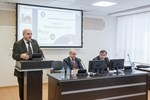Participation in large-scale, unique international scientific and technical projects is among the most important orientations for Russia's R&D potential today. Without a doubt, the specialists capable of solving the most demanding and sophisticated tasks in this type of project are a very valuable resource.
How to attract domestic specialists to this kind of project was discussed on 12 March at the Moscow Engineering and Physics Institute, (MEPhI) within the framework of a round table dedicated to the "Participation of Russian specialists in international megaprojects: fundamental research." The round table was held by the magazine Atomic Expert and supported by the Strana Rosatom newspaper.
Important questions discussed during the round table were: How to develop a long term strategy for the participation of experts? Which resources and administrational solutions are required? On the efficient resolution of these issues depends the success of Russia's collaboration in megaprojects, as well as the development of Russia's fundamental R&D base.
The round table was moderated by Deputy Director of Rosatom's Innovations Management Complex, Oleg Patarakin, and the Pro-rector for Research at MEPhI, Anatoly Petrovskiy.
Anatoli Krasilnikov, head of the Russian Domestic Agency for ITER, presented a report on the human resource policy for the implementation of the ITER Project. In his estimation, "the training of specialists for the implementation of the national program in fusion should be considered as one of the key tasks of Russia's participation in ITER. We should work out and realize a rational system of staff training." Oleg Patarakin also put an accent on the strategic importance of the ITER Project. "ITER is a project of the highest world level, at the very core of science and technology. The project has long-lasting prospects, and specialists have the possibility of linking their professional lives to it."
The round table participants shared the common opinion that attracting young people to megaprojects is a task requiring a complex approach that should be addressed by educational and research organizations, as well as legal bodies on different levels. For Russia, one of the main conditions of successful staff training is the development of long-term research programs.
For further information (in Russian) please follow the link: www.atom-dpd.ru
Every year in February, when almond trees begin to bloom in Provence, the ITER CODAC team releases a new version of the CODAC Core System.
The 2013 edition (CODAC Core System v 4.0) is more robust, comes with a better operator interface, offers more features, and supports plant systems that need "fast control," for example plasma control systems that have to react within a strictly defined period of time. "Version 3.0 did it okay," says ITER Control System Division Head Anders Wallander. "Version 4.0 does it better."
CODAC (Control, Data Access and Communication) can be described as a software conductor that orchestrates the dialogue between the hundred-odd ITER plant systems ..."the system of systems that makes one entity of everything" ... the lingua franca that allows the magnets, blanket, tritium plant, cryostat and diagnostics to exchange signals and share information.
Working for the ITER project here and abroad, 55 organizations (Domestic Agencies, fusion labs, contractors) are presently using the CODAC Core System. An infrastructure has been set up to distribute the software to these and future organizations and to keep track of versions used. Training and user support is also provided.
The software package has recently demonstrated its efficiency on the Korean tokamak KSTAR and celebrated its " First Plasma," so to speak, last June at the Frascati Tokamak Upgrade (FTU) project in Italy. "The ITER CODAC system is truly becoming a world language," says Anders.
CODAC is already implemented and deployed to monitor the power consumption on the ITER site, providing the "power people" with a global view and data with which to charge the different contractors operating on site. "With these pilot applications, we're demonstrating that the system meets our expectations," says CODAC System Engineer Franck Di Maio. "We're demonstrating the system's credibility."
CODAC users throughout the world are no different from any personal software user: switching to an upgrade is both exciting and challenging. "Although we provide support for older versions, we want to convince companies to upgrade. And the way to do it is to provide new features and make the upgrade easy." In Franck Di Maio's v 4.0 User Manual, the list of changes, fixed bugs, and enhancements of all kinds occupy no less than six pages ...
Optimizing, upgrading and adapting ITER CODAC is "a process that will never end," says Anders. "There will always be new requirements—this is the main difference between an experimental facility and a power plant."
|
"Without denying the challenges," states Kattalai Ramachandran Sriram, "it is a time to be hopeful."
Sriram arrived on the day of his birthday, 25 February, to take over ITER's Finance, Budget & Management Directorate. He comes from the offices of the Comptroller and Auditor General of India where—with the exception of a six-year secondment to the Information Technology (IT) Audit Office in the Gulf state of Oman—he spent twenty-five years (1987-2012) specializing in performance and IT auditing.
Trained in electronics and communication engineering, with a Master's in Business Administration, he joined the Comptroller and Auditor General of India because of the "great scope" offered by a career in the civil services and an interest in improving public and financial accountability. Over the years he successfully passed certification in auditing IT systems, internal auditing, and cost and management auditing.
He fulfilled auditing missions in civil aviation, hydrocarbons and rural development, internalizing the three "e's" of the performance auditor along the way: Is the organization achieving its objectives effectively, maximizing its outputs (given the inputs) efficiently and managing its finances economically?
These "e's" were applied by Sriram and his four-person team to the Management Assessment of the ITER Organization in 2011. Leading this team, he says, was an experience that he looks back on as a privilege—never before had he had the charge to conduct an assessment of such a large-scale international scientific organization. He interviewed over 50 ITER employees and became familiar with ITER's organization and internal processes: "The goal," he says, "was to meet with a member of every division, section and sub-section."
On the challenge of ITER's in-kind procurement, the system by which ITER Members are all involved with the manufacturing of ITER components—in some cases exactly the same components—Sriram remarks: "For the ITER project, in-kind procurement is a challenge. Not a problem, not an issue, but a challenge."
From the beginning, he explains, ITER was established as a scientific collaboration. "It was perfectly legitimate for all participating Members to wish to build up their own scientific and industrial capacities." The challenge for the ITER Organization and the Domestic Agencies now, he says, is to ensure commonality of interests. He's seen one very positive change since the Assessment—the Unique ITER Team established last year. "This is exactly the way to do things ... a real improvement in processes."
As head of Finance, Budget & Management, Sriram will be leading the Finance & Budget Division, the Project Information System Section (IT), and the System Management Section (SMS) ... a very interesting "menu" of responsibilities. His 25-year career has left him well versed in financial management and IT—areas that interact extensively. And he sees great potential in the recent SMS group and its improvement program, which is already delivering value to the ITER Organization.
Sriram looks forward to the challenges and rewards of working in a multicultural environment. How can an organization integrate the best aspects of very diverse working styles and ensure that value is delivered? "Based on what I have seen and experienced, it is a time to be hopeful for the organization and the project."
In 1955 a young engineer working on nuclear fusion decided to work out exactly how enormous the task of achieving fusion is. Although his colleagues were optimistic about their prospects, he wanted to prove it to himself. His name was John Lawson, and his findings—that the conditions for fusion power relied on three vital quantities—became the landmark Lawson Criteria.
The genesis of Lawson's Criteria is simple enough—he calculated the requirements for more energy to be created than is put in, and came up with a dependence on three quantities: temperature (T), density (n) and confinement time (τ)*. With only small evolution thanks to some subtle changes of definition, this is basically the same figure of merit used by today's fusion scientists, the triple product, nτT.
The amount of energy created relies on particles colliding and fusing—the number of collisions is related to the number of particles in a certain region—thus n, the number density (not mass density) is Lawson's first criterion. This would seem encouraging for the prospective experiment, as creating high pressure is relatively easy. However there is a catch. At higher densities a process known as bremsstrahlung rears its ugly head, in which collisions between nuclei and electrons generate radiation. Bremsstrahlung can become so dominant that all the power in the plasma is radiated away; the optimum density conditions are surprisingly low, around a million times less dense than air.
Nonetheless the fusion collisions—between the nuclei—have to be at high speed. This allows the nuclei to overcome their electrostatic repulsion, and get close enough for the strong force that governs fusion to take over and stick the particles together. The speed of a gas or plasma particle is equivalent to its temperature: the second of Lawson's criteria.
Again there is a limit—if the two particles are moving really fast then the time they are in close enough proximity for fusion to occur decreases. The bremsstrahlung also increases at higher temperatures, due to faster moving electrons. The Goldilocks temperature turns out to be in the vicinity of 100—200 million degrees, a seemingly huge task in the fifties that has become a standard condition today.
* "τ" is the Greek letter tau (pronounced like "how").
|






